Stock exchange
| Part of a series on |
| Financial markets |
|---|
 |
| Bond market |
| Stock market |
| Other markets |
| Over-the-counter (off-exchange) |
| Trading |
| Related areas |
|
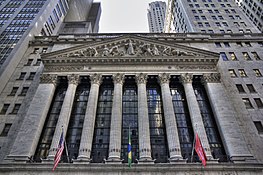
A stock exchange, securities exchange, or bourse is an
To be able to trade a security on a particular stock exchange, the security must be listed there. Usually, there is a central location for record keeping, but trade is increasingly less linked to a physical place as modern markets use electronic communication networks, which give them advantages of increased speed and reduced cost of transactions. Trade on an exchange is restricted to brokers who are members of the exchange. In recent years, various other trading venues such as electronic communication networks, alternative trading systems and "dark pools" have taken much of the trading activity away from traditional stock exchanges.[3]
Initial public offerings of stocks and bonds to investors is done in the primary market and subsequent trading is done in the secondary market. A stock exchange is often the most important component of a stock market. Supply and demand in stock markets are driven by various factors that, as in all free markets, affect the price of stocks (see stock valuation).
There is usually no obligation for stock to be issued through the stock exchange itself, nor must stock be subsequently traded on an exchange. Such trading may be off exchange or over-the-counter. This is the usual way that derivatives and bonds are traded. Increasingly, stock exchanges are part of a global securities market. Stock exchanges also serve an economic function in providing liquidity to shareholders in providing an efficient means of disposing of shares. In recent years, as the ease and speed of exchanging stocks over digital platforms has increased, volatility in the day-to-day market has increased, too.
History
The beginnings of lending were in Italy in the late Middle Ages. In the 1300s, Venetian lenders would carry slates with information on the various issues for sale and meet with clients, much like a broker does today. [4] Venetian merchants introduced the principle of exchanging debts between moneylenders; a lender looking to unload a high-risk, high-interest loan might exchange it for a different loan with another lender. These lenders also bought government debt issues.[5] As the natural evolution of their business continued, the lenders began to sell debt issues to the first individual investors. The Venetians were the leaders in the field and the first to start trading securities from other governments, yet did not embark on private trade with India. Nor did the Italians connect on land with the Chinese Silk Road. Along the potential overland trade route, Habsburg (Austrian) emperor Frederick II repulsed advances by Mongol Batu Kahn (Golden Horde) in 1241.[6] There is little consensus among scholars as to when corporate
Tradable


In England, the Dutch King William III sought to modernize the kingdom's finances to pay for its wars, and thus the first government bonds were issued in 1693 and the Bank of England was set up the following year. Soon thereafter, English joint-stock companies began going public.
London's first stockbrokers, however, were barred from the old commercial center known as the Royal Exchange, reportedly because of their rude manners. Instead, the new trade was conducted from coffee houses along
18th century
One of history's greatest
By the end of that same year, share prices had started collapsing, as it became clear that expectations of imminent wealth from the Americas were overblown. In London, Parliament passed the Bubble Act, which stated that only royally chartered companies could issue public shares. In Paris, Law was stripped of office and fled the country. Stock trading was more limited and subdued in subsequent decades. Yet the market survived, and by the 1790s shares were being traded in the young United States. On May 17, 1792, the New York Stock Exchange opened under a Platanus occidentalis (buttonwood tree) in New York City, as 24 stockbrokers signed the Buttonwood Agreement, agreeing to trade five securities under that buttonwood tree.[12]
19th century onwards

Bombay Stock Exchange was started by Premchand Roychand in 1875.[13] While BSE Limited is now synonymous with Dalal Street, it was not always so. In the 1850s, five stock brokers gathered together under a Banyan tree in front of Mumbai Town Hall, where Horniman Circle is now situated.[14] A decade later, the brokers moved their location to another leafy setting, this time under banyan trees at the junction of Meadows Street and what was then called Esplanade Road, now Mahatma Gandhi Road. With a rapid increase in the number of brokers, they had to shift places repeatedly. At last, in 1874, the brokers found a permanent location, the one that they could call their own. The brokers group became an official organization known as "The Native Share & Stock Brokers Association" in 1875.[15]
The Bombay Stock Exchange continued to operate out of a building near the
On 31 August 1957, the BSE became the first stock exchange to be recognized by the
In 1986, the BSE developed the S&P BSE SENSEX index, giving the BSE a means to measure the overall performance of the exchange. In 2000, the BSE used this index to open its derivatives market, trading S&P BSE SENSEX futures contracts. The development of S&P BSE SENSEX options along with equity derivatives followed in 2001 and 2002, expanding the BSE's trading platform.
Historically an open outcry floor trading exchange, the Bombay Stock Exchange switched to an electronic trading system developed by
Roles
This section needs additional citations for verification. (March 2018) |
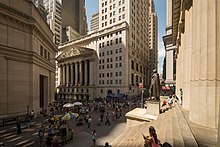
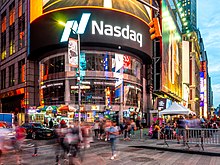


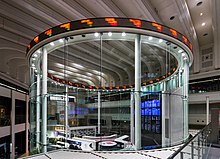
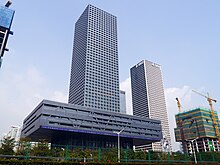

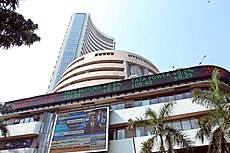
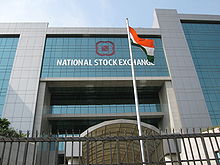

Stock exchanges have multiple roles in the economy. This may include the following:[17]
Raising capital for businesses
Besides the borrowing capacity provided to an individual or firm by the
Alternatives to stock exchanges for raising capital
Alternative investment funds refer to funds that include hedge funds, venture capital, private equity, angel funds, real estate, commodities, collectibles, structured products, etc. Alternative investment funds are an alternative to traditional investment options (stocks, bonds, and cash).
Research and Development limited partnerships
Companies have also raised significant amounts of capital through
Venture capital
A general source of capital for startup companies has been venture capital. This source remains largely available today, but the maximum statistical amount that the venture company firms in aggregate will invest in any one company is not limitless (it was approximately $15 million in 2001 for a biotechnology company).
Corporate partners
Another alternative source of cash for a private company is a corporate partner, usually an established multinational company, which provides capital for the smaller company in return for marketing rights, patent rights, or equity. Corporate partnerships have been used successfully in a large number of cases.
Mobilizing savings for investment
When people draw their savings and invest in shares (through an
Facilitating acquisitions
Companies view acquisitions as an opportunity to expand
Profit sharing
Both casual and professional
Corporate governance
By having a wide and varied scope of owners, companies generally tend to improve management standards and
Despite this claim, some well-documented cases are known where it is alleged that there has been considerable slippage in
Many banks and companies worldwide utilize securities identification numbers (
However, when poor financial, ethical or managerial records become public,
Creating investment opportunities for small investors
As opposed to other businesses that require huge capital outlay, investing in shares is open to both the large and small stock investors as minimum investment amounts are minimal. Therefore, the stock exchange provides the opportunity for small investors to own shares of the same companies as large investors.
Government capital-raising for development projects
Governments at various levels may decide to borrow money to finance infrastructure projects such as sewage and water treatment works or housing estates by selling another category of securities known as bonds. These bonds can be raised through the stock exchange whereby members of the public buy them, thus loaning money to the government. The issuance of such bonds can obviate, in the short term, direct taxation of citizens to finance development—though by securing such bonds with the full faith and credit of the government instead of with collateral, the government must eventually tax citizens or otherwise raise additional funds to make any regular coupon payments and refund the principal when the bonds mature.
Barometer of the economy
At the stock exchange, share prices rise and decreases depending, largely, on economic forces. Share prices tend to rise or remain stable when companies and the economy in general show signs of stability and growth. A
Listing requirements
Each stock exchange imposes its own
Examples of listing requirements
The listing requirements imposed by some stock exchanges include:
- New York Stock Exchange: the New York Stock Exchange (NYSE) requires a company to have issued at least 1.1 million shares of stock worth $40 million and must have earned more than $10 million over the last three years.[19]
- NASDAQ Stock Exchange: NASDAQ requires a company to have issued at least 1.25 million shares of stock worth at least $70 million and must have earned more than $11 million over the last three years.[20]
- London Stock Exchange: the main market of the London Stock Exchange requires a minimum market capitalization (£700,000), three years of audited financial statements, minimum public float (25%) and sufficient working capital for at least 12 months from the date of listing.
- Bombay Stock Exchange: Bombay Stock Exchange (BSE) requires a minimum market capitalization of ₹250 million (US$3.0 million) and minimum public float equivalent to ₹100 million (US$1.2 million).[21]
Ownership
Stock exchanges originated as
The Shenzhen Stock Exchange and Shanghai Stock Exchange can be characterized as quasi-state institutions insofar as they were created by government bodies in China and their leading personnel are directly appointed by the China Securities Regulatory Commission.
Another example is Tashkent Stock Exchange established in 1994, three years after the collapse of the Soviet Union, mainly state-owned but has a form of a public corporation (joint-stock company). Korea Exchange (KRX) owns 25% less one share of the Tashkent Stock Exchange.[22]
In 2018, there were 15 licensed stock exchanges in the United States, of which 13 actively traded securities. All of these exchanges were owned by three publicly traded multinational companies, Intercontinental Exchange, Nasdaq, Inc., and Cboe Global Markets, except one, IEX.[23][24] In 2019, a group of financial corporations announced plans to open a members owned exchange, MEMX, an ownership structure similar to the mutual organizations of earlier exchanges.[25][23]
Other types of exchanges
In the 19th century, exchanges were opened to trade forward contracts on commodities. Exchange traded forward contracts are called futures contracts. These commodity markets later started offering future contracts on other products, such as interest rates and shares, as well as options contracts. They are now generally known as futures exchanges.
See also
- Auction
- Asset allocation
- Capital market
- Commodities exchange
- Corporate governance
- Diversification (finance)
- Federation of Euro-Asian Stock Exchanges
- Financial regulation
- Financial risk management
- Histoire des bourses de valeurs (French)
- International Organization of Securities Commissions
- Securities market participants (United States)
- Stag profit
- Stock market crash
- Stock market bubble
- Stock exchanges for developing countries
- Stock market data systems
- Standard deviation
- Risk management
- World Federation of Exchanges
Lists:
- List of stock exchanges
- List of European stock exchanges
- List of stock exchanges in the Americas
- List of African stock exchanges
- List of stock exchanges in Western Asia
- List of South Asian stock exchanges
- List of East Asian stock exchanges
- List of Southeast Asian stock exchanges
- List of stock exchanges in Oceania
- List of countries without a stock exchange
- List of stock market indices
- List of stock market crashes and bear markets
- List of financial regulatory authorities by country
- List of Swiss financial market legislation
References
- ^ Kat Tretina and Benjamin Curry (9 April 2021). "NYSE: What Is The New York Stock Exchange". Forbes. Archived from the original on 23 June 2022. Retrieved 25 July 2022.
- ^ Lemke and Lins, Soft Dollars and Other Trading Activities, §2:3 (Thomson West, 2013-2014 ed.).
- ^ Lemke and Lins, Soft Dollars and Other Trading Activities, §§2:25 - 2:30 (Thomson West, 2013-2014 ed.).
- ISBN 9781421431444. Archivedfrom the original on 20 November 2022. Retrieved 20 November 2022.
- ^ "The Birth of Stock Exchanges". Archived from the original on 26 October 2007. Retrieved 20 November 2022.
- ^ "Letter of Güyük Khan to Pope Innocent IV". Vatican Secret Archives, Vatican City, Inv. No. A. A. (Arm. I-XVIII). 1245.
- ^ Beattie, Andrew (13 December 2017). "What Was the First Company to Issue Stock?". Investopedia. Archived from the original on 4 February 2020. Retrieved 22 March 2019.
- ISBN 0060150912.
- ISBN 978-0199811762). Edward P. Stringham & Nicholas A. Curott: "Business ventures with multiple shareholders became popular with commenda contracts in medieval Italy (Greif, 2006, p. 286), and Malmendier (2009) provides evidence that shareholder companies date back to ancient Rome. Yet the title of the world's first stock market deservedly goes to that of seventeenth-century Amsterdam, where an active secondary market in company shares emerged. The two major companies were the Dutch East India Company and the Dutch West India Company, founded in 1602 and 1621. Other companies existed, but they were not as large and constituted a small portion of the stock market (Israel [1989] 1991, 109–112; Dehing and 't Hart 1997, 54; dela Vega [1688] 1996, 173)."
- ^ De la Vega, Joseph, Confusion de Confusiones (1688), Portions Descriptive of the Amsterdam Stock Exchange, introduction by Hermann Kellenbenz, Baker Library, Harvard Graduate School of Business Administration (1957)
- ^ "Stockbroker 101 - A Cool History". Stockbroker 101. Archived from the original on 22 August 2018. Retrieved 22 March 2019.
- ^ "History of the NY Stock Exchange". Library of Congress. May 2004. Archived from the original on 4 April 2016. Retrieved 22 March 2019.
- ^ "BSE may set another record, become an official tourist spot". The New Indian Express. Press Trust of India. 6 October 2017. Archived from the original on 4 November 2021. Retrieved 4 November 2021.
- ^ "THE PROFILE OF BOMBAY STOCK EXCHANGE LIMITED".
- ^ "The History of Bombay Stock Exchange". YouTube. Archived from the original on 30 October 2021.
- ^ "BSEIndia". BSEIndia. Archived from the original on 22 January 2014. Retrieved 28 July 2010.
- JSTOR 1815367.
- from the original on 9 May 2023. Retrieved 16 December 2019.
- ^ "Overview of NYSE Quantitative Initial Listing Standards" (PDF). New York Stock Exchange. Archived (PDF) from the original on 18 May 2018. Retrieved 22 March 2019.
- NASDAQ. Archivedfrom the original on 27 September 2010. Retrieved 5 July 2006.
- ^ "Bombay Stock Exchange". Bombay Stock Exchange. Archived from the original on 5 September 2021. Retrieved 22 March 2019.
- ^ "Stages of the Republican Stock Exchange". Tashkent Stock Exchange. Archived from the original on 29 February 2020. Retrieved 22 March 2019.
- ^ a b Lahiri, Diptendu (7 January 2019). "Major Wall Street players plan exchange to challenge NYSE, Nasdaq". Reuters. Archived from the original on 9 January 2019. Retrieved 8 January 2019.
- ^ Ramsay, John (23 May 2018). "Competition among exchanges has reached a new low, and it's dangerous for the stock market". Business Insider. Archived from the original on 9 January 2019. Retrieved 8 January 2019. (for recent history see also, "NYSE, Nasdaq and...? Get to Know the U.S.'s Stock Exchanges, Part 1". Financial Industry Regulatory Authority. 17 August 2016. Archived from the original on 7 May 2019. Retrieved 8 January 2019., and "Get to Know the U.S.'s Major Stock Exchanges, Part 2". Financial Industry Regulatory Authority. 17 August 2016. Archived from the original on 7 May 2019. Retrieved 8 January 2019.
- ^ Osipovich, Alexander (7 January 2019). "Wall Street Firms Plan New Exchange to Challenge NYSE, Nasdaq". The Wall Street Journal. Archived from the original on 9 January 2019. Retrieved 8 January 2019.
External links
- Stock exchange at Curlie
